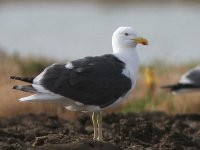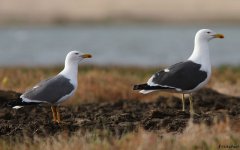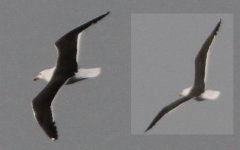Acrocephalus
Well-known member

Hi,
I don’t know if this went unnoticed here in BF or I missed it. I just noticed that this has been discussed in July in the SB forum and with inputs from people who freshly arrived from a birding trip from Morocco. It seems that the “big gulls” at Kniffiss Lagoon are not all Kelp Gulls as assumed by almost all birders who visited the site recently (the exception so far are Richard Bonser et al. 2010, see below), but some are rather Great Black-backed Gulls. http://www.surfbirds.com/forum/showthread.php?t=7147
This quote from the “Morocco and Western Sahara 3rd – 14th July 2010” trip report by Richard Bonser, Josh Jones, Oliver Metcalf and Dan Pointon (7th July 2010):
Josh Jones in post 25 in the above link wrote:
I went there on a short visit just to see the site as the tide was very high that day, so these gulls are yet to be seen by me.
regards,
I don’t know if this went unnoticed here in BF or I missed it. I just noticed that this has been discussed in July in the SB forum and with inputs from people who freshly arrived from a birding trip from Morocco. It seems that the “big gulls” at Kniffiss Lagoon are not all Kelp Gulls as assumed by almost all birders who visited the site recently (the exception so far are Richard Bonser et al. 2010, see below), but some are rather Great Black-backed Gulls. http://www.surfbirds.com/forum/showthread.php?t=7147
This quote from the “Morocco and Western Sahara 3rd – 14th July 2010” trip report by Richard Bonser, Josh Jones, Oliver Metcalf and Dan Pointon (7th July 2010):
After some observation and nifty photographic skills, we were able to walk away having confidently clinched a pair of Kelp Gulls amongst half a dozen Great Black-backed Gulls; leg colour, structure and restricted white primary mirrors were much more satisfactory than last year when we, along with everybody else, just presumed all were Kelp Gulls.
Josh Jones in post 25 in the above link wrote:
Thanks guys - let's hope it spurs the considerable number of WP listers who have been to this site and seen large black-backed gulls (and ticked Cape Gull without really paying much attention) to revisit and see them 'properly'... I for one will hold my hands up and admit that I didn't pay much attention to the 10 birds I saw in April 2009, and am glad I've now consciously identified a couple of Cape Gulls!
I went there on a short visit just to see the site as the tide was very high that day, so these gulls are yet to be seen by me.
regards,
Last edited:







